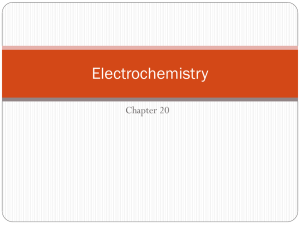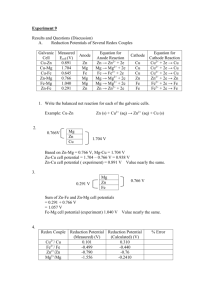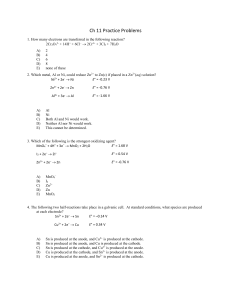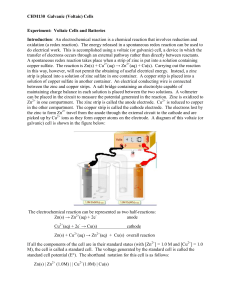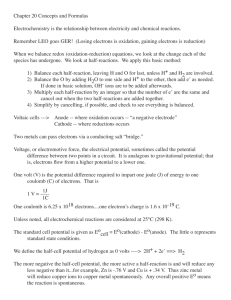Chapter 21 Electrochemistry, Week 1
advertisement
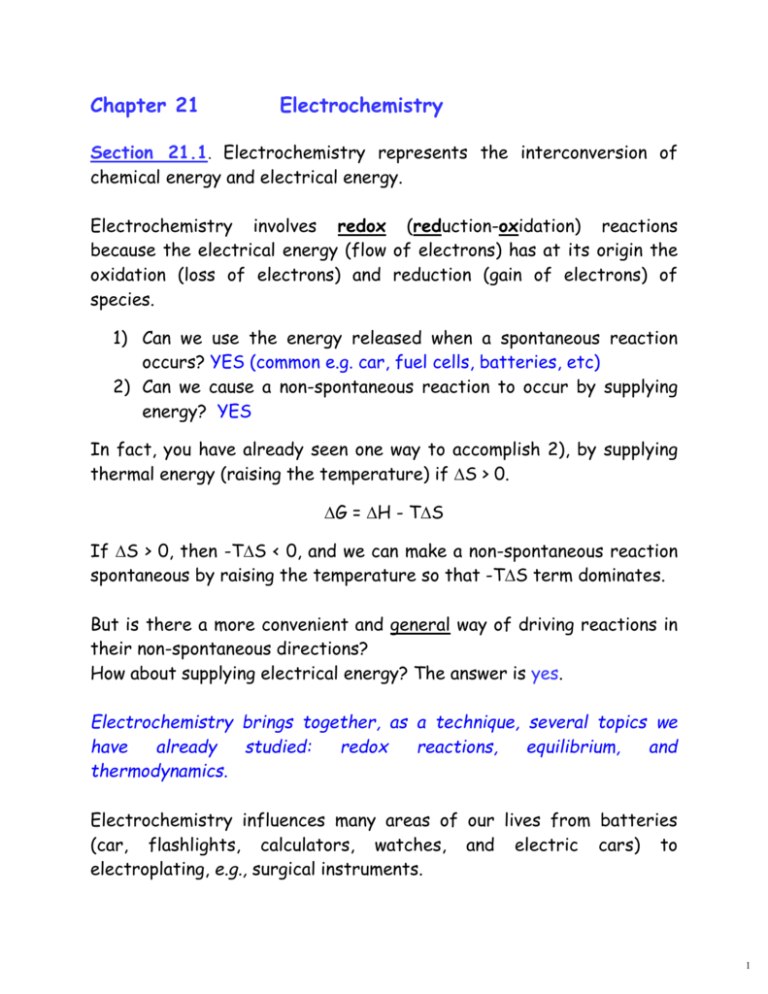
Chapter 21 Electrochemistry Section 21.1. Electrochemistry represents the interconversion of chemical energy and electrical energy. Electrochemistry involves redox (reduction-oxidation) reactions because the electrical energy (flow of electrons) has at its origin the oxidation (loss of electrons) and reduction (gain of electrons) of species. 1) Can we use the energy released when a spontaneous reaction occurs? YES (common e.g. car, fuel cells, batteries, etc) 2) Can we cause a non-spontaneous reaction to occur by supplying energy? YES In fact, you have already seen one way to accomplish 2), by supplying thermal energy (raising the temperature) if S > 0. G = H - TS If S > 0, then -TS < 0, and we can make a non-spontaneous reaction spontaneous by raising the temperature so that -TS term dominates. But is there a more convenient and general way of driving reactions in their non-spontaneous directions? How about supplying electrical energy? The answer is yes. Electrochemistry brings together, as a technique, several topics we have already studied: redox reactions, equilibrium, and thermodynamics. Electrochemistry influences many areas of our lives from batteries (car, flashlights, calculators, watches, and electric cars) to electroplating, e.g., surgical instruments. 1 Definitions of Oxidation and Reduction Oxidation = removal of one or more electrons Reduction = addition of one or more electrons Figure 21.1 Oxidizing agent = substance that is doing the oxidation (taking the electrons) Reducing agent = substance that is doing the reduction (giving the electrons) If something is oxidized, its oxidation state (ox. state) increases. If something is reduced, its oxidation state decreases. e.g. add Zn metal to acid (e.g. HCl) - bubbles of H2 gas form. The equation is Zn(s) + 2 H+ (aq) → Zn2+ (aq) + H2 (g) For the reaction as written left-to-right: Zn(s) is the reducing agent, giving electrons (e-) to H+ (aq) H+(aq) is the oxidizing agent, taking e- from Zn (s) Zn(s) is being oxidized (it is losing e-) (ox. state Zn0 increases to Zn2+) H+(aq) is being reduced (it is gaining e-) (ox. state H1+ decreases to H0) For the reverse reaction right-to-left H2(g) is the reducing agent and Zn2+(aq) is the oxidizing agent H2(g) is getting oxidized, and Zn2+(aq) is getting reduced. Note: The oxidizing agent is the substance being reduced. The reducing agent is the substance being oxidized. 2 Balancing Redox Reactions We must keep track of the exchange of electrons among species in a redox reaction. Consider the skeleton reaction: Sample Problem 21.1 MnO4- (aq) + C2O42- (aq) MnO2 (s) + CO32- (aq) 1. Write the two (or more) half-reactions. MnO4- (aq) MnO2 (s) and C2O42- (aq) CO32- (aq) (ox. state changes: Mn + 7 to + 4 and C +3 to +4) 2. Balance the atoms which change in oxidation state. MnO4- (aq) MnO2 (s) C2O42- (aq) 2 CO32- (aq) See Section 4.5 for ox. state calcs. and redox reactions. 3. Add or remove electrons, as needed, to balance oxidation state changes. 3e- + MnO4- (aq) MnO2 (s) C2O42- (aq) 2CO32- (aq) + 2e4. Balance the reduction and oxidation half reactions by balancing the electrons gained and lost. 6e- + 2MnO4- (aq) 2MnO2 (s) 3 C2O42- (aq) 6CO32- (aq) + 6 e5. Now add the half reactions (electrons should not appear; they should cancel!) 2 MnO4- (aq) + 3 C2O42- (aq) 2 MnO2 (s) + 6 CO32- (aq) 3 6. Balance atoms (other than O and H) that do not change in oxidation state. 7. Now balance O by adding H2O as needed, then balance H by adding H+ as needed. 2 H2O + 2 MnO4- (aq) + 3 C2O42- (aq) 2 MnO2 (s) + 6 CO32- (aq) 2H2O + 2 MnO4- (aq) + 3 C2O42- (aq) 2MnO2 (s) + 6 CO32- (aq) + 4H+ This is the FINAL BALANCED REDOX EQUATION if the reaction was done in acidic or neutral solution 8. When reaction is done in basic solution, add as many OH- to both sides as it takes to neutralize the acid (H+ + OH- H2O). 2H2O + 2MnO4- (aq) + 3C2O42- (aq) 2MnO2 (s) + 6 CO32- (aq) + 4 H+ Add 4 OH- to each side, and cancel some waters, to give: 4OH- + 2H2O + 2MnO4-(aq) + 3C2O42-(aq) 2MnO2(s) + 6CO32-(aq) + 4H2O This is the FINAL BALANCED REDOX EQUATION in basic solution 4 OH-(aq) + 2 MnO4- (aq) + 3 C2O42- (aq) 2 MnO2 (s) + 6 CO32- (aq) + 2 H2O(l) See also CrO42- rxn, page 853: Cr2O72- (aq) + I- (aq) Cr3+ (aq) + I2 (s) 4 An Overview of Electrochemical Cells Figure 21.2 1. A voltaic or galvanic cell uses a spontaneous reaction (G < 0) to generate electrical energy. Thus reactants have higher chemical potential energy (free energy) than products. All batteries contain voltaic cells. (System does work on the surroundings.) 2. An electrolytic cell uses electrical energy to drive a nonspontaneous reaction (G > 0). Thus, products have higher free energy than reactants, e.g., metal plating. (Surroundings to work on the system.) Section 21.2. VOLTAIC CELLS Fig. 21.3 (Zn bar in Cu2+ solution) - a spontaneous reaction Fig. 21.4 (the resulting Zn/Cu Voltaic cell) We find that the concentration of the zinc solution increases over time, concentration of copper solution decreases over time. We find mass of zinc rod decreases. Copper metal is deposited on the copper rod. Electrons flow through the external circuit, e.g., can light a bulb, run a heater, etc. Left compartment Zn (s) Zn2+ + 2 e Right compartment Cu2+ + 2 e- Cu (s) Salt bridge serves to keep the solution neutral; without the salt bridge the Zn2+ solution would become positively charged and the Cu2+ solution would become negatively charged, and the reaction would stop. ** reduction occurs at the cathode (= red cat) ** 5 Notation for a Voltaic Cell Zn (s) + Cu2+ (aq) Zn2+ (aq) + Cu (s) Zn (s) | Zn2+ (aq) || Cu2+ (aq) | Cu (s) anode cathode salt bridge 1) Anode = source of electrons; Cathode = where they go to be used 2) vertical bars (|) indicate a phase boundary 3) electrodes placed at far left and right. If electrode is not involved in half-reaction, put it at end and show reagents in order they appear in half-reaction. 4) concs and pressures are shown. If not, assume 1 M and 1 atm. 5) Use comma to separate components in the same phase. e.g., 2 I- (aq) I2 (s) + 2 e- (anode i.e. source of e-) MnO4- (aq) + 8 H+ (aq) + 5 e- Mn2+ (aq) + 4 H2O (l) (cathode i.e. where e- go to be used in a reduction) Electrodes are graphite, platinum, etc.: not involved in reactions. graphite | I- (aq) | I2 (s) || MnO4- (aq), H+ (aq), Mn2+(aq) | graphite or Pt (s) | I- (aq) | I2 (s) || MnO4- (aq), H+ (aq), Mn2+(aq) | Pt (s) Sample Problem 21.2 Cr bar dipping in Cr(NO3)3 solution on one side of cell, Ag bar in AgNO3 solution on the other side, and connected by salt bridge. The Cr electrode is the negative one. Draw diagram, and give cell reaction and cell notation. 6 Since Cr (s) | Cr3+ (aq) is the negative electrode , it is the anode Ag (s) | Ag+ (aq) is the positive electrode it is the cathode) Cr (s) Cr3+ (aq) + 3 e- (anode, source of e-, put on left of cell) Ag+ (aq) + e- Ag (s) (cathode, where e- are used, put on right of cell) Cr (s) + 3 Ag+ (aq) Cr3+ (aq) + 3 Ag (s) and cell notation is Cr (s) | Cr3+ (aq) || Ag+ (aq) | Ag (s) Why and how long does a Voltaic Cell Work? Why? Because the reaction is spontaneous. How Long? Until the reaction is no longer spontaneous. Recall: G = G° + RT ln Q. At the start, G < 0. As concs in the anode and cathode cells change, Q increases i.e. G becomes less negative. When G = 0, reaction is at equil, the cell is fully discharged, and no more electrons flow. Section 21.3. Cell Potential Reaction is spontaneous if G < 0. The reaction drives the current from anode to cathode. In electrochemistry language, we talk about the cell potential (Ecell) or electromotive force (emf), i.e., the electrical potential difference (or "voltage" in everyday English) between the anode and cathode (units volts) Ecell results from the spont. rxn. related to G. G = - nFEcell n = Number of electrons exchanged in balanced chemical reaction. F = Faraday Constant = 9.65 x 104 J/V.mol e- 7 if G < 0, G > 0, G = 0, Ecell > 0 (spontaneous = Voltaic cell) Ecell < 0 (non-spontaneous = Electrolytic cell) Ecell = 0 (equilibrium) Remember: G = wmax G and Ecell tell us maximum work the cell can do. Standard Cell Potentials Measured cell potential (Ecell) depends on concs and pressures. At standard conditions (1 atm gas, 1 M solutions): Ecell = E°cell E°cell = standard cell potential E°cell for Zn/Cu cell = 1.10 V. Zn(s) | Zn2+ (aq, 1 M) || Cu2+ (aq, 1 M) | Cu (s) How can we measure E°cell ? Experimentally, we can use a voltmeter How can we calculate E°cell ? We use E°half-cell for the two half-reactions Half-Cell Electrode Potentials (E°half-cell) Each half of cell has a half-cell potential that together give total Ecell or E°cell. By convention, half-cell potentials refer to half-reactions written as reductions i.e. ox + e- red (ox = oxidized form; red = reduced form) and this is the way they are listed in Tables such as Appendix D 8 Reversing direction changes sign of half-cell potential. So, for Zn (s) + Cu2+ (aq) Zn2+ (aq) + Cu (s) Zn2+ (aq) + 2 e- Zn (s) E°Zn (listed in App. D like this) Cu2+ (aq) + 2 e- Cu (s) E°cathode = E°Cu (listed like this) In the cell, the Zn half-reaction happens in the opposite direction (oxidation), so we change the sign: Zn (s) Zn2+ (aq) + 2 e- E°anode = -E°Zn Now, E°cell is the sum of the two half-cell rxns. E°cell = E°cathode + (-E°anode) = E°Cu + (-E°Zn) Since the anode is always an oxidn, E°anode = -E°half-rxn always E°cell = E°cat – Eanode ** Note: the minus sign already takes into account the fact that the anode reaction occurs in the opposite direction from that listed in Appendix D, so do NOT change the sign of numbers you take from Appendix D and plug into this equation! ** Determining E°half-cell with the Standard H2 Electrode E°cell is related to G. G not known absolutely, only differences (G). Similarly, we measure differences in half-cell E° values, by always measuring them vs. a reference electrode. Reference electrode = standard hydrogen electrode (SHE) SHE = Pt solid dipping in 1 M aq strong acid through which 1 atm H2 gas is bubbled. This is, by convention, given a value of 0.00 V 2 H+ (aq, 1M) + 2 e- H2 (g, 1 atm) E°ref = 0.00 V 9 So, we construct voltaic cell with SHE on one side and unknown on other; we can get unknown E°, since E°cell is known (measured with a voltmeter) E°cell = E°cat - Eano If SHE is cathode: E°cell = 0.00 - Eunk E°cell = -Eunk If SHE is anode: E°cell = E°unk - 0.00 E°cell = E°unk This way, E°half-cell for any half-cell can be obtained. Appendix D Example 1: Zn (s) | Zn2+ (aq) || Cu2+ (aq) | Cu (s) E°cell = E°cat – E°ano = +0.34 V –(- 0.76 V) = 1.10 V **NOTE: use numbers straight from table! Do not change sign ** Measured E°cell = 1.10 V. Example 2: Voltaic cell: Br2 (aq) + Zn (s) Zn2+ (aq) + 2 Br- (aq) E°cell = 1.83 V. If E°Zn = -0.76 V, what is E°Br for the half-reaction below? Br2 (aq) + 2 e- 2 Br- (aq) E°cell = E°cat – E°ano Zn (s) Zn2+ (aq) + 2 e-; it is the anode E°cell = E°Br - E°Zn 1.83 V = E°Br -(- 0.76 V) = E°Br + 0.76 V E°Br = 1.83 V - 0.76 V E°Br = 1.07 V CHECK: E°cell = E°cat – E°ano = 1.07 V - (- 0.76 V) = 1.83 V (Correct!) 10 Example 3: E°cell = 1.39 V for the rxn below. What is E° for VO2+ V3+? Br2 (aq) + 2 V3+ (aq) + 2 H2O (l) 2 VO2+ (aq) + 4 H+ (aq) + 2 Br- (aq) Br2 (aq) + 2 e- 2 Br- (aq) the cathode E°cat = 1.07 V E°cell = E°cat – E°ano 1.39 V = 1.07 V – E°anode E°anode = 1.07 – 1.39 = - 0.32 V E°VO2+ V3+ = - 0.32 V Relative Strengths of Oxidizing and Reducing Agents E°half-cell values represent how easy or difficult it is to add electrons comparing E°half-cell gives us strengths of oxidizing/reducing agents. e.g. Cu2+ (aq) + 2 e- Cu (s) 2 H+ (aq) + 2 e- H2 (g) Zn2+ (aq) + 2 e- Zn (s) E° = + 0.34 V E° = 0.00 V E° = - 0.76 V The bigger (more +ve, or less -ve) the E°, the easier is the reduction The smaller (more –ve, or less +ve) the E°, the harder is the reduction Conversely, The bigger (more +ve, or less -ve) the E°, the harder is the oxidation The smaller (more –ve, or less +ve) the E°, the easier is the oxidation reducing strength: Zn > H2 > Cu oxidizing strength: Cu2+ > H+ > Zn2+ General Rule: Strength of reducing agent increases as E°half-rxn becomes smaller (down Table 21.2 or Appendix D). Strength of oxidizing agent increases as E°half-rxn becomes bigger (up Table 21.2 or Appendix D). 11 Predicting Direction of Spontaneous Reactions E° values are related to G we can use them to predict spontaneity Cu (s) + Zn2+ (aq) weaker red. ag. ? ? weaker ox. ag. Cu2+ (aq) + Zn (s) stronger ox. ag. stronger red. ag. ** stronger red/ox agents win, and push the reaction towards the other side ** spontaneous direction is right-to-left i.e., e-s grabbed by stronger oxid. agent (Cu2+) converting it to Cu (s). i.e., electrons flow from the smaller E°half-rxn to the larger E°half-rxn (Note: Example Negative numbers are smaller than positive numbers! ) (Remember: ox + n e- red) Mn2+ (aq) + 2 e- Mn (s) Sn2+ (aq) + 2 e- Sn (s) Mn (s) + Sn2+ (aq) spont. E°half-rxn = -1.18 V E°half-rxn = -0.14 V Mn2+ (aq) + Sn (s) Sample Problem 21.4 NO3- (aq) + 4 H+ (aq) + 3 e- NO (g) + 2 H2O (l) N2 (g) + 5 H+ (aq) + 4 e- N2H5+ (aq) MnO2 (s) + 4 H+ + 2 e- Mn2+ (aq) + 2 H2O (l) E° = 0.96 V E° = - 0.23 V E° = 1.23 V Reducing strength: N2H5+ > NO > Mn2+ Oxidizing strength: MnO2 > NO3- > N2 12 Spontaneous Reactions are: 1. 2. 3. 3 N2H5+ (aq) + 4 NO3- (aq) + H+ (aq) N2 (g) + 4 NO + 8 H2O (l) 2 NO (g) + 3 MnO2 (s) + 4 H+ 2 NO3- (aq) + 3 Mn2+ (aq) + 2 H2O (l) N2H5+ (aq) + 2 MnO2 (s) + 3 H+ N2 (g) + 2 Mn2+ (aq) + 4 H2O (l) E°cell (1) = 0.96 V - (-0.23 V) = 1.19 V E°cell (2) = 1.23 V - (0.96 V) = 0.27 V E°cell (3) = 1.23 V – (-0.23 V) = 1.46 V 13


